
James Francis Cagney Jr. was an American actor and dancer. On stage and in film, he was known for his consistently energetic performances, distinctive vocal style, and deadpan comic timing. He won acclaim and major awards for a wide variety of performances.

The Public Enemy is a 1931 American pre-Code gangster film produced and distributed by Warner Bros. The film was directed by William A. Wellman and stars James Cagney, Jean Harlow, Edward Woods, Donald Cook and Joan Blondell. The film relates the story of a young man's rise in the criminal underworld in Prohibition-era urban America. The supporting players include Beryl Mercer, Murray Kinnell, and Mae Clarke. The screenplay is based on an unpublished novel—Beer and Blood by two former newspapermen, John Bright and Kubec Glasmon—who had witnessed some of Al Capone's murderous gang rivalries in Chicago.

Angels with Dirty Faces is a 1938 American crime drama film directed by Michael Curtiz for Warner Brothers. It stars James Cagney, Pat O'Brien, The Dead End Kids, Humphrey Bogart, Ann Sheridan, and George Bancroft. The screenplay was written by John Wexley and Warren Duff based on the story by Rowland Brown. The film chronicles the relationship of the notorious gangster William "Rocky" Sullivan with his childhood friend and now-priest Father Jerry Connolly. After spending three years in prison for armed robbery, Rocky intends to collect $100,000 from his co-conspirator Jim Frazier, a mob lawyer. All the while, Father Connolly tries to prevent a group of youths from falling under Rocky's influence.

George Raft was an American film actor and dancer identified with portrayals of gangsters in crime melodramas of the 1930s and 1940s. A stylish leading man in dozens of movies, Raft is remembered for his gangster roles in Quick Millions (1931) with Spencer Tracy, Scarface (1932) with Paul Muni, Each Dawn I Die (1939) with James Cagney, Invisible Stripes (1939) with Humphrey Bogart, and Billy Wilder's comedy Some Like It Hot (1959) with Marilyn Monroe and Jack Lemmon; and as a dancer in Bolero (1934) with Carole Lombard and a truck driver in They Drive by Night (1940) with Ann Sheridan, Ida Lupino and Bogart.
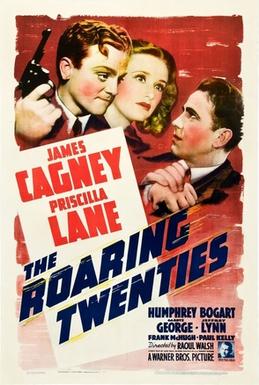
The Roaring Twenties is a 1939 American crime thriller film directed by Raoul Walsh and starring James Cagney, Priscilla Lane, Humphrey Bogart, and Gladys George. The film, spanning the period from 1919 to 1933, was written by Jerry Wald, Richard Macaulay and Robert Rossen. The film follows three men and their experiences during major events in the 1920s, such as Prohibition era violence and the 1929 stock market crash.

Three on a Match is a 1932 American pre-Code crime drama film released by Warner Bros. The film was directed by Mervyn LeRoy and stars Joan Blondell, Warren William, Ann Dvorak, and Bette Davis. The film also features Lyle Talbot, Humphrey Bogart, Allen Jenkins, and Edward Arnold.

Each Dawn I Die is a 1939 gangster film directed by William Keighley and starring James Cagney and George Raft. The plot involves an investigative reporter who is unjustly thrown in jail and befriends a famous gangster. The film was based on the novel of the same name by Jerome Odlum and the supporting cast features Jane Bryan, George Bancroft, Slapsie Maxie Rosenbloom, and Victor Jory.
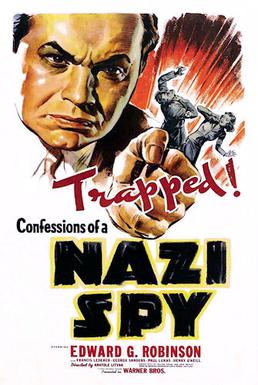
Confessions of a Nazi Spy is a 1939 American spy political thriller film directed by Anatole Litvak for Warner Bros. It was the first explicitly anti-Nazi film to be produced by a major Hollywood studio, being released in May 1939, four months before the beginning of World War II and two and a half years before the United States' entry into the war.
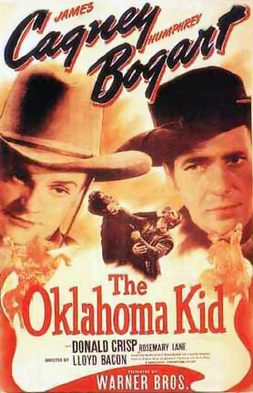
The Oklahoma Kid is a 1939 Western film starring James Cagney and Humphrey Bogart. The film was directed for Warner Bros. by Lloyd Bacon. Cagney plays an adventurous gunslinger in a broad-brimmed cowboy hat while Bogart portrays his black-clad and viciously villainous nemesis. The film is often remembered for Cagney's character rubbing the thumb and forefinger of his hand together and exulting, "Feel that air!"
The Federal Bureau of Investigation (FBI) has been a staple of American popular culture since its christening in 1935. That year also marked the beginning of the popular "G-Man" phenomenon that helped establish the Bureau's image, beginning with the aptly titled James Cagney movie, G Men. Although the detective novel and other police-related entertainment had long enthralled audiences, the FBI itself can take some of the credit for its media prominence. J. Edgar Hoover, the Bureau's "patriarch", took an active interest to ensure that it was not only well represented in the media, but also that the FBI was depicted in a heroic, positive light and that the message, "crime doesn't pay", was blatantly conveyed to audiences. The context, naturally, has changed profoundly since the 1930s "war on crime", and especially so since Hoover's death in 1972.
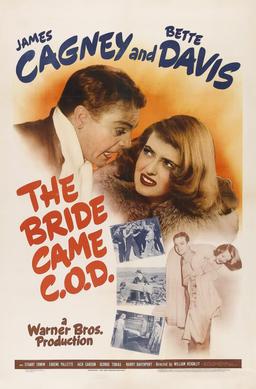
The Bride Came C.O.D. is a 1941 American screwball romantic comedy starring James Cagney as an airplane pilot and Bette Davis as a runaway heiress, and directed by William Keighley. Although the film was publicized as the first screen pairing of Warner Bros.' two biggest stars, they had actually made Jimmy the Gent together in 1934, and had wanted to find another opportunity to work together.

White Heat is a 1949 American film noir directed by Raoul Walsh and starring James Cagney, Virginia Mayo and Edmond O'Brien.

Arthur Raymond "Doc" Barker was an American criminal, the son of Ma Barker and a member of the Barker-Karpis gang, founded by his brother Fred Barker and Alvin Karpis. Barker was typically called on for violent action, while Fred and Karpis planned the gang's crimes. He was arrested and convicted of kidnapping in 1935. Sent to Alcatraz Federal Penitentiary in 1936, he was killed three years later while attempting to escape.
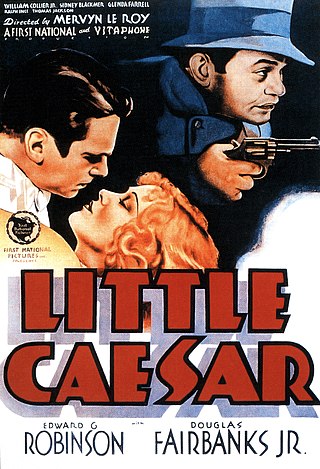
Little Caesar is a 1931 American pre-Code crime film distributed by Warner Brothers, directed by Mervyn LeRoy, and starring Edward G. Robinson, Glenda Farrell, and Douglas Fairbanks Jr. In 2000, Little Caesar was included in the annual selection of 25 motion pictures added to the National Film Registry of the Library of Congress being deemed "culturally, historically, or aesthetically significant" and recommended for preservation. The film tells the story of a hoodlum who ascends the ranks of organized crime until he reaches its upper echelons. The storyline, based on real life Mafia boss Salvatore Maranzano, was adapted from the novel of the same name by William R. Burnett. Little Caesar was Robinson's breakthrough role and immediately made him a major film star. The film is often listed as one of the first fully-fledged gangster films and continues to be well received by critics. The Library of Congress maintains a print.

The Millionaire is a 1931 all-talking pre-Code comedy film produced and distributed by Warner Bros. and starring George Arliss in the title role. The film is a remake of the 1922 film titled The Ruling Passion, which also starred Arliss. The film was based on the short story "Idle Hands" by Earl Derr Biggers. In one of his early film roles, James Cagney had a brief but key appearance as a life insurance salesman. The supporting cast features Florence Arliss, David Manners, Evalyn Knapp, Noah Beery Sr., Cagney, J. Farrell MacDonald, Charley Grapewin and Tully Marshall.
Mafia films—a version of gangster films—are a subgenre of crime films dealing with organized crime, often specifically with Mafia organizations. Especially in early mob films, there is considerable overlap with film noir. Popular regional variations of the genre include Italian Poliziotteschi, Chinese Triad films, Japanese Yakuza films, and Indian Mumbai underworld films.

Little Big Shot is a 1935 American film directed by Michael Curtiz, and starring Sybil Jason and Glenda Farrell. The film was released by Warner Bros. on September 7, 1935. The plot concerns a young girl who endears herself to her caretakers after her father is murdered by mobsters.
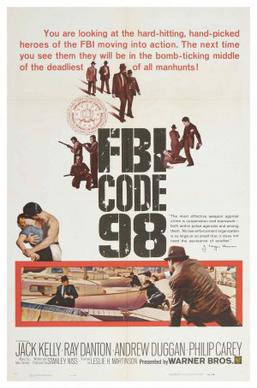
FBI Code 98 is a 1962 crime drama directed by Leslie H. Martinson and produced by Warner Bros. Originally intended as television pilot, the film was instead released theatrically in the United Kingdom in 1962, and in the United States in 1963. FBI Code 98 stars many Warner Bros. contract players such as Jack Kelly, Ray Danton, Andrew Duggan and William Reynolds who later costarred on the Warner Bros Television show The F.B.I.. The film was narrated by William Woodson, who had previously narrated the radio show The FBI in Peace and War.

The Big Shot (1942) is an American film noir crime drama film starring Humphrey Bogart as a crime boss and Irene Manning as the woman he falls in love with. Having finally reached stardom with such projects as The Maltese Falcon (1941), this would be the last film in which former supporting player Bogart would portray a gangster for Warner Bros..

Adrian Michael Morris was an American actor of stage and film, and a younger brother of Chester Morris.




















